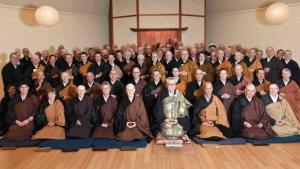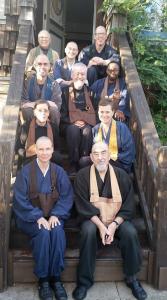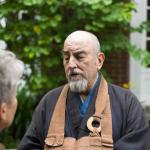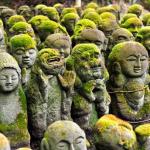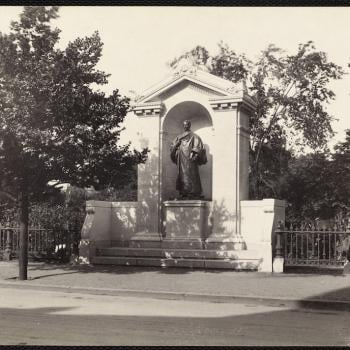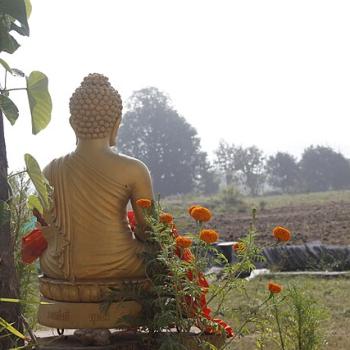Here I am at the Oakland airport waiting on my flight home to Long Beach. Yesterday I completed a three-year term on the board of the Soto Zen Buddhist Association. Now, I’m jumbling through my thoughts and feelings about the experience.
I’ve devoted the majority of my life to the Zen project. My heart aligns most closely with Soto Zen Buddhism informed by the koan curriculum adapted from the Hakuin line Takujo system by the great Soto master Daiun Sogaku Harada at the turn of the last century. I was first ordained unsui close to fifty years ago and later received dharma transmission from the late English Soto priest Houn Jiyu Kennett. My practice continued under the lay koan master John Tarrant, and later as a collaborator in the formation of Boundless Way Zen.
This ranging experience has meant while I am deeply on the inside of the Soto Zen ordained way, I viscerally resist clericalism and advocate for unambiguous acknowledgment of lay practice and that lay practitioners can be full masters of our way. Today, I am working with other Soto Zen priests and lay leaders in forming a Soto sangha in Long Beach and Orange County.
And, most of all, I’m concerned about the possibilities of Zen for a fulfilled life. I see it as one of the true ways. It is powerful. It is lovely. And it is a most human enterprise. So, it is also dreadfully frustrating. And, always, it appears, always totters at the edge of collapse.
And it is from this perspective that I find myself thinking about the SZBA.
It is only twenty-two years old. In 1995 representatives of the Sotoshu suggested to some senior American priests that it was time for Westerners to organize their own Soto alliance. The following year the Soto Zen Buddhist Association was formally incorporated. Sojun Mel Weitsman was the SZBA’s first president. However, it wasn’t until 2001 that the organization began to take shape. In 2004 Jisho Caroline Warner became the third president and the SZBA held its first conference.
It was at this conference that a Dharma Heritage ceremony was initiated to replace the Japanese Soto zuise ceremony for North American practitioners. Twelve American priests who had completed the zuise ceremony officiated at the ceremony, initiating thirty senior American priests. I was honored to be among that number. And doubly so when invited to be Doshi, principal celebrant at the fifth Dharma Heritage ceremony in 2012.
Since then the SZBA has offered a variety of services to the practicing community. This has included a webpage, list serve, intensive workshops, and training periods. In 2008 the SZBA formally adopted a critical document, “Guidelines for the Formation of Soto Zen Priests in the West.” In 2010 the SZBA approved a new document honoring women ancestors. In 2011 an SZBA Ethics Statement was issued. In the same year the SZBA reincorporated with new bylaws. It has continued to be the only organization with which the Japanese Sotoshu maintains connections, even if largely informally.
Today there are approximately two hundred full members and another hundred, plus, associates. We represent lineages derived through Tozen Akiyama, Kobun Chino, Betsugen Joshin, Dainin Katagiri, Jiyu Kennett, Taizan Maezumi, Daito Noda, Tesumei Niho, Guido Nishijima, Seido Suzuki, and Shunryu Suzuki. And more. We keep growing.
One of the early leaders of the SZBA the late Kyogen Carlson envisioned the SZBA as a proto-denomination, an organization that might bind the various individual lineages that have come to North America and the West. And with that to create expectations of preparation as well as ethical guidelines and networking.
The need for some commonly understood training standards has become increasingly important over the years. Unlike in Japan with long established forms, here we are literally the wild west. And something unusual has happened here. Because of the romance of Zen’s dharma transmission there are a growing number of people who have been given Zen titles, but who have had little and on occasion no training.
This has happened before. In Japan. And in China. In Medieval Europe this phenomenon occurred around Christian ordination and such people were called hedge-priests. Some of these Zen priests also show characteristics in common with the Christian Episcopi Vagantes movement.
As with Episcopus Vagans, a few of these people are amazing practitioners and teachers. And, I like that there is the possibility of creativity at the edges of a tradition. But, mostly, this is simply a problem. Inadequately prepared and often inappropriate people are using titles, and frankly, misleading people about what Zen is and can be.
For the sake of our emerging Western Soto Zen those of us who are seriously committed, finding common ground among practitioners and teachers is critical. And that includes finding standards of preparation. It means the difference between an authentic spiritual tradition taking root here and a beautiful discipline dissolving into a playground for egoists seeking approval without doing the work. So, while Kyogen Roshi’s hope for a denomination is not on the immediate horizon, seeking commonly accepted objective standards to underline what dharma transmission should mean is critical.
And during my tenure our principal struggle focused on one thing. This was finding accord on a standards component to the formation document. The sticking point was intensive monastic training. In Soto Zen this is usually experienced in the form of ango, ninety-day cloistered practice. The Japanese Sotoshu ordinarily requires two ango as part of priestly formation. This question and how it should apply to the SZBA has taken up nearly a decade of discussion.
Part of the problem is coming to agreement as to what precisely Soto Zen ordination is. Normative ordination throughout Buddhism’s history has been vinaya monasticism. So normative in fact that the word sangha, which today in the West is understood in much the same way as “church,” to mean both the local gathering of Buddhists and the larger Buddhist community, was originally meant only the vinaya ordained community.
However in Japan starting in the ninth century a reformed ordination system based in the Bramajala Bodhisattva precepts was introduced through the Tendai school. While initially simply meant as an alternative form of full monastic ordination, through those mysterious accidents of history, something new emerged in Japan. Today Soto Zen clerics ordained through the Sixteen Bodhisattva precepts are not expected to be celibate, be vegetarian, or shave their heads.
The great Shin founder Shinran Shonin spoke of this new ordained way that has evolved in Japan as being “neither monk nor lay.” Instead of monks, but also not lay people, Japanese Buddhist clergy are sometimes called “married monks,” but probably are best called “priests.”
In a recent article on this blog I used that term “married monk,” attempting to capture the unique quality of Soto ordination, how it has monastic components but is not celibate. The intensity of the negative reactions on the inter webs, while magnified by being on the inter webs, shows that the term is probably not adaptable into normative English.
The word “priest” is associated with leading ceremonial functions, and that certainly is an aspect of the work and discipline of a Soto priest. But, also it can mean a “technologist of the spirit.” And within the Zen tradition, this would suggest a certain mastery of one or more of the Zen arts of contemplation. And that works. Finally, if we consider how the word priest literally means “elder,” from the Latin presbyter, a Zen priest would be both a trained technologist of the spirit and an elder with the community.
And when it comes to a Zen priest, a Soto Zen priest, there are a number of things one should be able to expect. In my view the number one thing is that person should be a competent meditation teacher. This person should have had extensive experience and have been assessed by others to be able to guide people on the path of zazen. Less important to me, but historically very important, and critical to many, and I believe important to the establishment of Zen here, the Soto priest should also be competent in the leading of Soto Zen’s various rituals. A Soto Zen priest in the west to have teaching, counseling, and spiritual direction skills. And, increasingly there is need for traditional Western ministerial skillsets.
But most of all this person should be a dedicated practitioner of Zen. Without this the rest cannot follow. But, how to establish this? Fortunately in more serious Zen circles fewer and fewer are tangled in the myth of dharma transmission and see it as sufficient. Some want to acknowledge the need for preparation but resist any institutional markers. Others see the need to continue that monastic formation found in extensive monastic residency, or, at the very least in the form of an ango or two or three or four.
The problem included the fact many people who are Soto Zen priests have not had this experience. Also there is a legitimate concern that as many people as possible who feel the “call” of ordained life be given the opportunity to do it. In an era where people who ordain cannot expect to be professionals, that is be paid as priests and teachers, what training demands are reasonable? Especially when monastic formation removes one from the opportunity to earn money and to save for one’s old age. And depending on when that monastic experience is taken on, this can have dire consequences for people’s future lives. There are also questions about people with minor children or other obligations.
I came on the board having served for ten years on the membership of the only other substantial group of Zen teachers in the West, the American Zen Teachers Association. While it has no aspirations beyond being a forum for mutual support among Zen teachers it did run up against the question, “Who is a Zen teacher?”
What we found was that whatever else might be true about the formation of a Zen teacher, whether a layperson, a priest, or a monk, or a nun, whatever other experiences or training led to their obtaining a title what everyone who “felt” one of the group to the others had extensive Zen meditation experience. Trying to put a number to that the membership committee established one year of intensive meditation experience. What in Japanese Zen we would call “sesshin” days, days with between eight and eleven hours of meditation. And, so my strongly held position was that we should forgo the ango requirement in favor of sesshin days.
We struggled mightily with this.
And in the end like Horace sings to us:
And don’t start like the old writer of epic cycles:
‘Of Priam’s fate I’ll sing, and the greatest of Wars.’
What could he produce to match his opening promise?
Mountains will labour: what’s born? A ridiculous mouse!
Basically we agreed that normative formation for a Soto Zen Buddhist priest should include as a minimum one ango. As a compromise with the circumstances of our times this ango expectation can be met with four three week residential intensives.
It was hard for me to vote for this, but I did. I felt, and actually, still feel that a single ango is both too much and not enough, in that that residency requirement means a lot of people will simply not be able to meet the expectation, and at the same time a single ango is no where near enough to make a priest. As to that second part, this isn’t meant to be sufficient, merely necessary.
As to the first part, that’s where I struggled. I looked at my own life, and while I completed approximately four ango (I no longer can count precisely. It was nearly fifty years ago), the truth is that I would not be teaching if it weren’t for the twenty years I spent doing koan introspection with a number of teachers.
But, there is something about Soto Zen ordination that is more than preparing a minister, or even a Zen teacher. And here that difficult term “married monk” keeps returning. As unsatisfactory as it is. Maybe better “neither monk nor lay.” But it is something. We who walk this path are joined together within what I guess I would have to call an order, a community of practitioners with some few things in common. And, that monastic element, I reluctantly acknowledge, is authentically part of the package.
It was also important for me to clarify in my own mind that ordination as a Soto priest is not the only way to acknowledge mastery of our way, and not the essential parts. I can easily give full authorization as a teacher to a lay person. Well, not easily, that person must walk the way for many years, have sat at least that year of sesshin, and probably have completed the Harada reformed koan curriculum. I can only hope this truth of lay mastery will be accepted within our Western Soto in time. It certainly happens here and there now. One of the largest streams of Soto Zen in the West the White Plum acknowledge lay masters. More will follow.
And for me knowing that allows me to open more fully to what it means to be a priest.
That said, embracing the Soto Zen priest way means we do need to find ways to foster the whole of it, and that does mean including monastic formation. Precisely how, I suspect is still open. But, the obvious way is through ango.
And that’s that. Three years. A mouse. But, who knows what this mouse might become?
Its not long before my flight home.
I am tired. A little disappointed I couldn’t have done more. And grateful for the opportunity to share in this amazing work that is planting Soto Zen here on Turtle Island.
May all beings be well…


